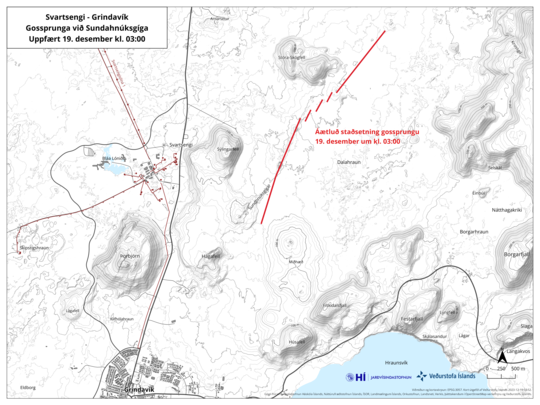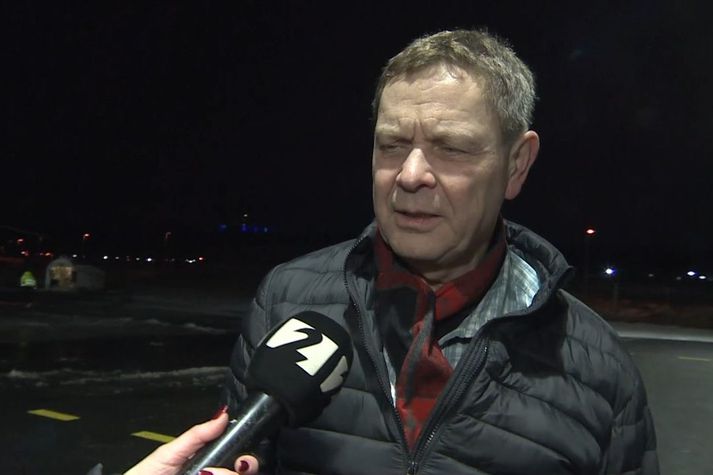- Thread starter
- #121
In such a complex tectonic environment, this layperson is not about to try to interpret the fracture style, but it is amazing -- textbook case!
Follow along with the video below to see how to install our site as a web app on your home screen.
Note: This feature may not be available in some browsers.
Updated on December 19, at 02:50
Rather, the power of the eruption that started about four hours ago seems to be reducing. It can be seen on both seismometers and GPS meters. The fact that the activity is already reducing is not an indication of how long the eruption will last, but rather that the eruption is stabilizing. This trend has been seen at the beginning of all the eruptions on the Reykjanes Peninsula in recent years.
Eruption continues throughout the entire fissure, with the greatest intensity around the center of the fissure in the area marked "Zone 3" and shown in orange on the hazard assessment map released a week ago. a>
The crack is about 4 km long and the northern end of the crack is just east of Stóra-Skógfell and the southern end is just east of Sundhnúk. The distance from the southern end to the edge of Grindavík is almost 3 km.
The Norwegian Meteorological Agency will continue to monitor the development of the activity and is in direct contact with civil defense and emergency responders in the area. The Watch will post information on the development of the scenario under "Expert Comments" as deemed necessary. A consultation meeting of scientists will be held this morning.
This news will be updated at 9, 19 December.

Magnús Tumi Guðmundsson is a professor of geophysics.INDEX/EINAR
It can be expected that the flow of lava from the eruption on the Reykjanes Peninsula will decrease rapidly. A geophysicist says the eruption is in the best place given the conditions. Lava does not flow towards Grindavík, and it has to flow a long way to reach the defenses at Svartsengi.
-- Source (autotranslated)
Updated December 19, at 12:30 p.m
The power of the volcanic eruption at Sundhnúks crater continues to decrease. Lava flow is roughly estimated at ¼ of what it was at the start and a third of the original fissure is active. The magma plumes are also lower than at the beginning of the eruption, about 30 meters at their highest. These numbers are a visual assessment from a survey flight, another measurement flight is scheduled at 13 today, where a clearer picture is obtained of the development of the activity.
The development of the eruption is similar to the volcanic eruption at Fagradalsfjall, where the fissures have started to contract and form single vents. At this point there are about five gosops scattered along the original crack.
According to the information of scientists who went on the second helicopter flight of the Coast Guard around As of 4:00 a.m., the total length of the eruption zone had not changed much since the beginning. There was little activity at the southern end of the fissure at Hagafell, and the largest lava flow is looking east towards Fagradalsfjall. Two reins extend to the west, both north of Stóra-Skógfell.
Today, the plume of soda is coming from the west and north-west direction. Gas pollution may be noticed in Vestmannaeyjar today, but not elsewhere in the settlement. According to the weather forecast, gas pollution could be noticed in the capital area late tonight or in the morning.
A new hazard assessment map is being developed and will be published later today.
-- IMO
I'm learning all the Icelandic I can! Thanks for sharing this. So, in an earlier post, you said that they were working on lava barriers. What type of material is used for that? I've seen lava do all kinds of things to different materials.
No visible eruption activity
However, it is possible that the lava flow is in closed channels
21.12.2023
Updated December 21 at 9:45 a.m
Scientists flying over the craters confirm that no eruptive activity is visible and that the craters appear to be extinguished, but embers are still visible in the lava bed. This was also confirmed by an Efla employee who is in Sýlingarfell. The activity seems to have gone down late last night or very early this morning. However, it is still possible that the lava flow is in closed channels and therefore it is premature to declare the eruptions closed.
6 hours ago
The eruption is probably over, but it's not time to spend the night in Grindavík

Magnús Tumi Guðmundsson, professor of geophysics, says that magma accumulation under Svartsengi, which seems to have started again, is similar to before the eruption at Sundhnúksgíga began.
"It built up before the eruption, these weeks, enough pressure and then it broke, what to say, the lid or something like that - and this broke out. It did not manage to flow up continuously and the eruption is probably over. Then the magma starts to accumulate again below because the flow deeper has continued as it was before the eruption."
He says it is just as likely that it will erupt again if it continues like this. "If magma continues to flow from below into this chamber beneath Svartsengi, then we are expected to have a similar scenario again."
He says weeks to months can pass before that happens, and that the chain of events can also stall.
Magnús Tumi says that reassessing the danger in Grindavík will be considered, but it is clear that it is not time for people to spend the night in the town.
6 hours ago
Most likely, magma will continue to accumulate under Svartsengi for weeks or months
Halldór Geirsson, a geophysicist at the Earth Sciences Institute, says that the most likely scenario after magma accumulation begins again under Svartsengi is that it continues to accumulate there for a few weeks or months and then escapes from the magma chamber.
Freysteinn Sigmundsson, a geophysicist at the University of Iceland, says ...
... there are various factors that need to be considered.
"The most important thing at this stage is to pay close attention to the sequence of events, assess what this magma flow is and make a small assessment of what might be needed to trigger a new eruption," says Freysteinn.
"The Earth's crust doesn't behave like that regularly, we don't really know where the limits are to trigger a new event. Now you have to pay close attention."
Freysteinn Sigmundsson. mbl.is/Sigurður Bogi
